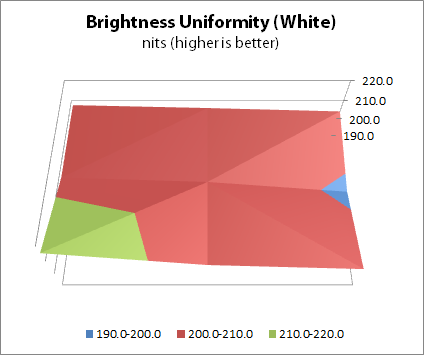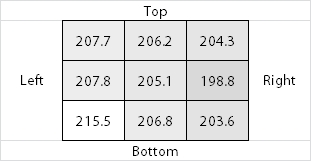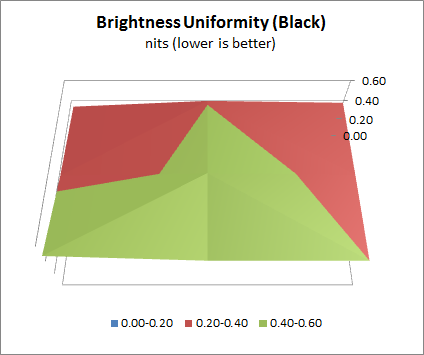NEC PA301w: The Baddest 30-inch Display Around
by Brian Klug on March 1, 2011 8:00 AM ESTBrightness Uniformity
For brightness uniformity, we test at the same 9 points we measure Delta-E on, but this time measure white and black levels when the center point is as close to 200 nits as we can get. We use the same colorimeter and software as before, - an Xrite i1D2 and ColorEyes Display Pro. Similar to the ordinary brightness test (taken at the center), contrast is set to 100 in the OSD and brightness is set to as close to 200 as possible in the center before measurements are taken.
White Uniformity


Black Uniformity


It appears that the PA301w's built-in uniformity settings help keep the brightness profile very steady in the full on white test. There's a tiny horizontal dependence from left to right, but it's imperceptible in practice, and the standard deviation of these readings is just 4 nits. Uniformity in the white department is actually very good.
Blacks are a little worse, again the bottom left seems to be brighter than the rest of the display by a measurable and consistent amount. On the whole again though the consistency is pretty good. Displaying a purely black image, there's also no obvious light leakage anywhere on the display.










92 Comments
View All Comments
7Enigma - Wednesday, March 2, 2011 - link
Are you seriously going to be frequently moving a 60+ pound display?erson - Tuesday, March 1, 2011 - link
Great review Brian. Regarding Eizo current FlexScan 30" is getting pretty "old". Their brand new 27" SX2762W with dual displayports (v1.1a) looks more interesting for the pro-consumer I imagine.Any word of monitors with displayport v1.2 support for daisy-chaining?
Conficio - Tuesday, March 1, 2011 - link
instead of "The baddest..."JarredWalton - Tuesday, March 1, 2011 - link
No. Bad, worse, worst is correct if you're talking about a negative connotation, but if you're using bad like in "oh, he's a total bad-ass!" you would never say, "Yeah, but I'm a worse-ass!" LOLLuay - Tuesday, March 1, 2011 - link
https://www.hazro.co.uk/shop.html#ecwid:category=4...They sell in the UK but do ship overseas and are priced cheaper than any 2560x1600 out there. You will find reviews for their models in TFT central.
DanNeely - Tuesday, March 1, 2011 - link
If you're asking about reviews; I believe that with rare exceptions review models are provided by the manufacturer not bought by the anandtech staff; so unless Hazro offers to send a review sample they won't be reviewed here.eaw999 - Wednesday, March 2, 2011 - link
warranty issues would be a pain for anyone overseas though.gammaray - Tuesday, March 1, 2011 - link
2200$+ ...is this a freaking joke?
DanNeely - Tuesday, March 1, 2011 - link
It's the same price as the outgoing 3090. Ezio sells high end displays for a similar price. These aren't intended as high end consumer displays like the Dell/HP models. They're aimed at professional customers; typically commercial photographers, and video producers.A big part of the price is probably panel binning, not all panels in a batch are equal and the manufactures charge a big premium for the best of the lot (less variation, fewer dead pixels, etc).
The image processor in the multisync 90 series added about $200 to the cost and was used to farther normalize variations across the panel so you didn't end up with things like a bright corner. I'd assume the current model's processor is less expensive, but probably not by a lot.
Finally the price premium from all the extra features that don't matter to consumers pushes the total cost up higher, since it cuts into the total customer base. $1300 vs $1800 is a big deal for a consumer on a budget, $1800 vs $2300 is much less for a (typically corporate) customer who has a need for the best on the market.
hp540 - Tuesday, March 1, 2011 - link
$2200 is not a joke. Actually, it's a drop in the bucket - depending on your perspective.I'm not a radiologist, but I read films as part of my work. Our radiology workstations use dual Eizo monitors. 2 x $2200 doesn't even come close to the full cost of these stations - it's not the workstations. It's not the computer. Most of the money the hospital pays is for the PAX software licensing fees.